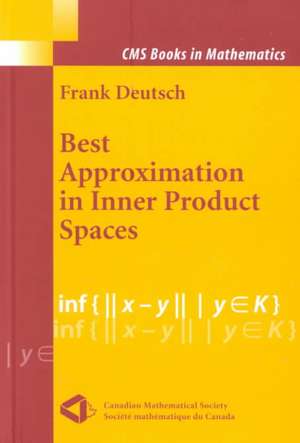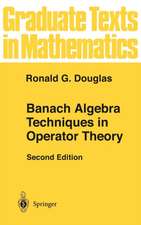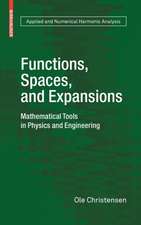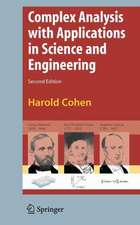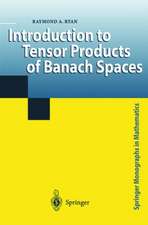Best Approximation in Inner Product Spaces: CMS Books in Mathematics
Autor Frank R. Deutschen Limba Engleză Hardback – 20 apr 2001
| Toate formatele și edițiile | Preț | Express |
|---|---|---|
| Paperback (1) | 391.61 lei 6-8 săpt. | |
| Springer – 3 dec 2010 | 391.61 lei 6-8 săpt. | |
| Hardback (1) | 399.29 lei 6-8 săpt. | |
| Springer – 20 apr 2001 | 399.29 lei 6-8 săpt. |
Din seria CMS Books in Mathematics
- 20%
 Preț: 942.92 lei
Preț: 942.92 lei - 17%
 Preț: 429.86 lei
Preț: 429.86 lei - 15%
 Preț: 787.71 lei
Preț: 787.71 lei -
 Preț: 322.22 lei
Preț: 322.22 lei - 18%
 Preț: 780.97 lei
Preț: 780.97 lei - 15%
 Preț: 690.59 lei
Preț: 690.59 lei -
 Preț: 399.29 lei
Preț: 399.29 lei -
 Preț: 386.00 lei
Preț: 386.00 lei - 15%
 Preț: 644.30 lei
Preț: 644.30 lei -
 Preț: 368.24 lei
Preț: 368.24 lei -
 Preț: 392.37 lei
Preț: 392.37 lei - 18%
 Preț: 784.92 lei
Preț: 784.92 lei -
 Preț: 493.34 lei
Preț: 493.34 lei - 15%
 Preț: 443.91 lei
Preț: 443.91 lei - 15%
 Preț: 641.20 lei
Preț: 641.20 lei - 24%
 Preț: 699.00 lei
Preț: 699.00 lei -
 Preț: 389.88 lei
Preț: 389.88 lei - 15%
 Preț: 537.23 lei
Preț: 537.23 lei -
 Preț: 400.10 lei
Preț: 400.10 lei - 20%
 Preț: 547.87 lei
Preț: 547.87 lei - 15%
 Preț: 524.88 lei
Preț: 524.88 lei -
 Preț: 395.85 lei
Preț: 395.85 lei -
 Preț: 397.01 lei
Preț: 397.01 lei -
 Preț: 391.79 lei
Preț: 391.79 lei -
 Preț: 483.05 lei
Preț: 483.05 lei -
 Preț: 497.00 lei
Preț: 497.00 lei - 15%
 Preț: 645.28 lei
Preț: 645.28 lei -
 Preț: 356.60 lei
Preț: 356.60 lei - 15%
 Preț: 639.41 lei
Preț: 639.41 lei - 15%
 Preț: 648.56 lei
Preț: 648.56 lei -
 Preț: 492.37 lei
Preț: 492.37 lei - 15%
 Preț: 478.05 lei
Preț: 478.05 lei -
 Preț: 389.49 lei
Preț: 389.49 lei - 15%
 Preț: 486.86 lei
Preț: 486.86 lei
Preț: 399.29 lei
Nou
Puncte Express: 599
Preț estimativ în valută:
76.43€ • 83.05$ • 64.24£
76.43€ • 83.05$ • 64.24£
Carte tipărită la comandă
Livrare economică 21 aprilie-05 mai
Preluare comenzi: 021 569.72.76
Specificații
ISBN-13: 9780387951560
ISBN-10: 0387951563
Pagini: 338
Ilustrații: XVI, 338 p.
Dimensiuni: 155 x 235 x 21 mm
Greutate: 0.68 kg
Ediția:2001
Editura: Springer
Colecția Springer
Seria CMS Books in Mathematics
Locul publicării:New York, NY, United States
ISBN-10: 0387951563
Pagini: 338
Ilustrații: XVI, 338 p.
Dimensiuni: 155 x 235 x 21 mm
Greutate: 0.68 kg
Ediția:2001
Editura: Springer
Colecția Springer
Seria CMS Books in Mathematics
Locul publicării:New York, NY, United States
Public țintă
GraduateCuprins
1. Inner Product Spaces.- Five Basic Problems.- Inner Product Spaces.- Orthogonality.- Topological Notions.- Hilbert Space.- Exercises.- Historical Notes.- 2. Best Approximation.- Best Approximation.- Convex Sets.- Five Basic Problems Revisited.- Exercises.- Historical Notes.- 3. Existence and Uniqueness of Best Approximations.- Existence of Best Approximations.- Uniqueness of Best Approximations.- Compactness Concepts.- Exercises.- Historical Notes.- 4. Characterization of Best Approximations.- Characterizing Best Approximations.- Dual Cones.- Characterizing Best Approximations from Subspaces.- Gram-Schmidt Orthonormalization.- Fourier Analysis.- Solutions to the First Three Basic Problems.- Exercises.- Historical Notes.- 5. The Metric Projection.- Metric Projections onto Convex Sets.- Linear Metric Projections.- The Reduction Principle.- Exercises.- Historical Notes.- 6. Bounded Linear Functionals and Best Approximation from Hyperplanes and Half-Spaces.- Bounded Linear Functionals.- Representation of Bounded Linear Functionals.- Best Approximation from Hyperplanes.- Strong Separation Theorem.- Best Approximation from Half-Spaces.- Best Approximation from Polyhedra.- Exercises.- Historical Notes.- 7. Error of Approximation.- Distance to Convex Sets.- Distance to Finite-Dimensional Subspaces.- Finite-Codimensional Subspaces.- The Weierstrass Approximation Theorem.- Müntz’s Theorem.- Exercises.- Historical Notes.- 8. Generalized Solutions of Linear Equations.- Linear Operator Equations.- The Uniform Boundedness and Open Mapping Theorems.- The Closed Range and Bounded Inverse Theorems.- The Closed Graph Theorem.- Adjoint of a Linear Operator.- Generalized Solutions to Operator Equations.- Generalized Inverse.- Exercises.- Historical Notes.- 9. The Method of AlternatingProjections.- The Case of Two Subspaces.- Angle Between Two Subspaces.- Rate of Convergence for Alternating Projections (two subspaces).- Weak Convergence.- Dykstra’s Algorithm.- The Case of Affine Sets.- Rate of Convergence for Alternating Projections.- Examples.- Exercises.- Historical Notes.- 10. Constrained Interpolation from a Convex Set.- Shape-Preserving Interpolation.- Strong Conical Hull Intersection Property (Strong CHIP).- Affine Sets.- Relative Interiors and a Separation Theorem.- Extremal Subsets of C.- Constrained Interpolation by Positive Functions.- Exercises.- Historical Notes.- 11. Interpolation and Approximation.- Interpolation.- Simultaneous Approximation and Interpolation.- Simultaneous Approximation, Interpolation, and Norm-preservation.- Exercises.- Historical Notes.- 12. Convexity of Chebyshev Sets.- Is Every Chebyshev Set Convex?.- Chebyshev Suns.- Convexity of Boundedly Compact Chebyshev Sets.- Exercises.- Historical Notes.- Appendix 1. Zorn’s Lemma.- References.
Recenzii
From the reviews:
MATHEMATICAL REVIEWS
"This monograph contains the first comprehensive presentation of best approximation in inner product spaces (e.g., Hilbert spaces)…The author has succeeded very well in presenting clearly this first systematic study of best approximation in inner product spaces. The book is a valuable source for teaching graduate courses on approximation theory and related topics. Students with some basic knowledge in advanced calculus and linear algebra will be able to understand the text, which is written very smoothly. Since best approximation problems appear in many different branches, this monograph of about 300 pages will be a useful tool for researchers in mathematics, statistics, engineering, computer science and other fields of applications."
F.R. Deutsch
Best Approximation in Inner Product Spaces
"The first comprehensive presentation of best approximation in inner product spaces."
— MATHEMATICAL REVIEWS
"Nice introduction to inner-product spaces, with the particular application in mind. Discusses existence, uniqueness, characterization, and error of best approximations. Intended for graduate students, but mathematically sophisticated undergraduate could learn a lot from this book."— AMERICAN MATHEMATICAL MONTHLY
"This monograph contains the first comprehensive presentation of best approximation in inner product spaces … . Moreover, at the end of each chapter there is a section with numerous exercises and one with notes in which the results are considered in a historical perspective. The author has succeeded very well in presenting clearly his first systematic study of approximation in inner product spaces. The book is a valuable source for teaching graduate courses … ." (Günther Nürnberger, Mathematical Reviews, Issue 2002 c)
"Nice introduction to inner-product spaces, with the particular application in mind. Discussesexistence, uniqueness, characterization, and error of best approximations. Intended for graduate students, but mathematically sophisticated undergraduates could learn a lot from this book. Twelve chapters, with exercise sets and historical notes." (American Mathematical Monthly, August-September, 2002)
"The central concern of this book is the best approximation problem … . As an introduction to approximation theory, this book serves quite well. The background required is just basic analysis and linear algebra, a number of important topics are covered and the explanations are clear. Each chapter ends with a variety of exercises and detailed historical remarks. It has well been proofread … . I think this book is destined to serve a number of purposes." (David Yost, The Australian Mathematical Society Gazette, Vol. 29 (2), 2002)
"This is an interesting and intriguing book, and to that extent it is already a success. Its principal aim is pedagogical; it is ‘the book of the course’ which the author has offered at the Pennsylvania State University for a number of years … . Each chapter is liberally supplied with exercises, the book contains a wealth of material and is a pleasure to read." (A. L. Brown, Zentralblatt MATH, Vol. 980, 2002)
"The book is based on a graduate course on Best Approximation taught by the author for over twenty five years at the Pennsylvania State University. … Each chapter ends with a set of exercises and very interesting historical notes. Written by a well-known specialist in best approximation theory, the book contains a good treatment of best approximation in inner product spaces and can be used as a textbook for graduate courses or for self-study." (Stefan Cobzas, Studia Universitatis Babes-Bolyai Mathematica, Vol. XLVII (2), 2002)
"This is a very nice book on approximation that can serve as a basis for course material, as well as for independent study. It is very nicely written, and … it takes thereader through many different fields and to considerable depth. … many pictures help the reader to comprehend the ideas and concepts. The book contains many examples and counterexamples … . I have found the problem section very interesting, and they are certainly very useful for students who are just learning the material." (Vilmos Totik, Acta Scientiarum Mathematicarum, Vol. 68, 2002)
MATHEMATICAL REVIEWS
"This monograph contains the first comprehensive presentation of best approximation in inner product spaces (e.g., Hilbert spaces)…The author has succeeded very well in presenting clearly this first systematic study of best approximation in inner product spaces. The book is a valuable source for teaching graduate courses on approximation theory and related topics. Students with some basic knowledge in advanced calculus and linear algebra will be able to understand the text, which is written very smoothly. Since best approximation problems appear in many different branches, this monograph of about 300 pages will be a useful tool for researchers in mathematics, statistics, engineering, computer science and other fields of applications."
F.R. Deutsch
Best Approximation in Inner Product Spaces
"The first comprehensive presentation of best approximation in inner product spaces."
— MATHEMATICAL REVIEWS
"Nice introduction to inner-product spaces, with the particular application in mind. Discusses existence, uniqueness, characterization, and error of best approximations. Intended for graduate students, but mathematically sophisticated undergraduate could learn a lot from this book."— AMERICAN MATHEMATICAL MONTHLY
"This monograph contains the first comprehensive presentation of best approximation in inner product spaces … . Moreover, at the end of each chapter there is a section with numerous exercises and one with notes in which the results are considered in a historical perspective. The author has succeeded very well in presenting clearly his first systematic study of approximation in inner product spaces. The book is a valuable source for teaching graduate courses … ." (Günther Nürnberger, Mathematical Reviews, Issue 2002 c)
"Nice introduction to inner-product spaces, with the particular application in mind. Discussesexistence, uniqueness, characterization, and error of best approximations. Intended for graduate students, but mathematically sophisticated undergraduates could learn a lot from this book. Twelve chapters, with exercise sets and historical notes." (American Mathematical Monthly, August-September, 2002)
"The central concern of this book is the best approximation problem … . As an introduction to approximation theory, this book serves quite well. The background required is just basic analysis and linear algebra, a number of important topics are covered and the explanations are clear. Each chapter ends with a variety of exercises and detailed historical remarks. It has well been proofread … . I think this book is destined to serve a number of purposes." (David Yost, The Australian Mathematical Society Gazette, Vol. 29 (2), 2002)
"This is an interesting and intriguing book, and to that extent it is already a success. Its principal aim is pedagogical; it is ‘the book of the course’ which the author has offered at the Pennsylvania State University for a number of years … . Each chapter is liberally supplied with exercises, the book contains a wealth of material and is a pleasure to read." (A. L. Brown, Zentralblatt MATH, Vol. 980, 2002)
"The book is based on a graduate course on Best Approximation taught by the author for over twenty five years at the Pennsylvania State University. … Each chapter ends with a set of exercises and very interesting historical notes. Written by a well-known specialist in best approximation theory, the book contains a good treatment of best approximation in inner product spaces and can be used as a textbook for graduate courses or for self-study." (Stefan Cobzas, Studia Universitatis Babes-Bolyai Mathematica, Vol. XLVII (2), 2002)
"This is a very nice book on approximation that can serve as a basis for course material, as well as for independent study. It is very nicely written, and … it takes thereader through many different fields and to considerable depth. … many pictures help the reader to comprehend the ideas and concepts. The book contains many examples and counterexamples … . I have found the problem section very interesting, and they are certainly very useful for students who are just learning the material." (Vilmos Totik, Acta Scientiarum Mathematicarum, Vol. 68, 2002)
